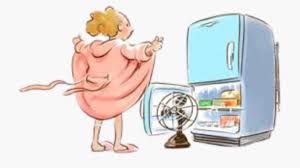
Have you ever wondered why some women seem to pass through peri-menopause/menopause easily while others experience mood swings, depression, pain or hot flushes?
Did you know that in some cultures there isn’t even a word that means menopause? It just doesn’t exist.
Want to learn how to cope or even avoid these seemingly uncontrollable symptoms?
What is menopause?
Menopause refers to the time when the menstrual cycle has completely ceased for 12 months. The normal age for the final period is anywhere from 45 to 55 so the normal age for perimenopause is up to ten years before that—as young as 35.
Perimenopause is not about aging but rather an important (and unavoidable) recalibration of your hormonal system. Perimenopause is the time when our ovaries wind down and the menstrual cycle slowly ceases. This can take anywhere between one to ten years and on average affects women in their mid-40’s, but as early as mid-30’s to early sixties. During the time of peri-menopause, the ovaries also decrease their production of oestrogen, eventually stopping completely.
You are genetically programmed to achieve menopause at approximately the age your mother or female relatives achieved it. If that’s on the younger end of normal (mid-40s), please know that you’re fine and healthy and not aging more rapidly than your friends. If, on the other hand, you’re genetically programmed to achieve menopause on the older end of normal (mid-50s), then your perimenopause is happening alongside aging but is not caused by aging.
Finally, if you enter menopause before age 40, it’s the medical condition of premature menopause or primary ovarian insufficiency and is also not about aging.
How to diagnose perimenopause
Menopause (including early menopause) can be diagnosed by two high FSH readings (more than 40 IU/L) at least a month apart.
Perimenopause cannot be diagnosed by FSH or any other lab test. Instead, it is assessed based on age and symptoms. According to Canadian endocrinology professor Jerilynn C Prior, a midlife woman with regular cycles is likely to be in perimenopause if she notices any three of the following nine changes:
- new-onset heavy and/or longer flow
- shorter menstrual cycles (25 days or less)
- new sore, swollen or lumpy breasts
- new mid-sleep waking
- increased menstrual cramps
- onset of night sweats, in particular premenstrually
- new or markedly increased migraine headaches
- new or increased premenstrual mood swings
- weight gain without changes in exercise or eating.
In other words, if you’re older than 35, and have at least three symptoms on this list, you’re likely to be in perimenopause. However, you can be in perimenopause with no symptoms at all other than gradually decreasing menstrual flow (shorter and/or ligher periods) gradually ceasing completely. Symptoms are generally an indication that the hormonal changes are out of balance – something that can be supported with dietary and lifestyle adjustments.
What are the hormonal changes of perimenopause?
In the early phases of perimenopause, the biggest change is lower progesterone due to shorter luteal phases and more anovulatory cycles—despite regular periods. Lower progesterone contributes to anxiety, breast pain, heart palpitations, night sweats, frequent migraines and crazy, heavy periods. At the same time that progesterone drops away, estrogen spikes up to three times normal which contributes to irritable mood, breast pain and heavy periods.

👉🏽 Tip: High estrogen symptoms stem both from the direct effects of the hormone and from estrogen’s indirect effects on mast cells and histamine.
The fact that perimenopausal symptoms stem largely from losing progesterone, not estrogen, is why progesterone, not estrogen, can be the better treatment. Also, just as a little reassurance, it is possible to conceive during perimenopause.
How to breeze through the transition
As the ovaries gradually cease producing oestrogen, the adrenal glands take up this task. This is the body’s natural Hormone Replacement.
In order to be able to make oestrogen, the adrenal glands require cholesterol and nutrients including specific vitamins, minerals and amino acids. A major factor which influences the adrenal glands’ ability to produce oestrogen is STRESS.
Today’s busy lifestyle with its many demands on our time and energy often leaves us feeling drained – both physically and emotionally. Prolonged stress reduces the adrenal glands’ ability to function adequately.
Lower oestrogen levels have been linked to osteoporosis. However, many lifestyle choices inhibit calcium absorption thereby contributing to poor bone density long before menopause sets in. These include:
- Alcohol, coffee, soft drinks, carbonated drinks
- Refined sugar
- Excess salt
- Diuretics, laxatives, tobacco smoke, marijuana and general intoxicants
- Tomatoes, potatoes, eggplant, capsicum
- Excess protein
I often get asked what foods provide a rich source of calcium. Contrary to marketing promotion, milk is a poor source of calcium, especially the low fat varieties. Research has shown that dairy depresses magnesium and Vitamin D levels, and itself contains little bio-available calcium. Processing removes natural minerals which are sometimes replaced with poor quality, less absorbed varieties.
Foods providing a rich source of calcium are sesame seeds, tahini, sardines, green leafy vegetables, almonds, buckwheat, egg yolk, molasses, soybeans and turnips. Essential for proper calcium absorption are magnesium and Vitamins D and K2. Furthermore, ensuring a balanced and healthy pH (acid-alkaline) is essential for healthy bones as being ‘acidic’ causes minerals to be leached from bones.
Many of the health conditions and risks associated with menopause can be prevented by –
- Reducing stress
- Adopting a healthy diet
- Monitoring your health on the inside
- Supplementing with herbs and nutrients where necessary
- Moderate regular exercise
- Adequate rest and quality sleep
Dagmar Ganser is a qualified naturopath and is able to advise you on all your nutritional needs. Self prescribing of any nutrient may have adverse effects so always seek professional guidance.
Dagmar uses quality practitioner-only, high grade products to ensure you get value for money and the successful outcomes you deserve.

Source: https://larabriden.com/
